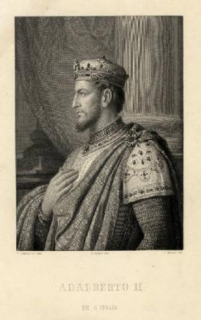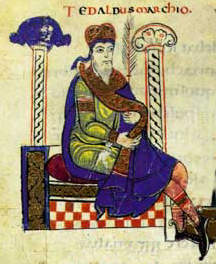
Berengar II was the King of Italy from 950 until his deposition in 961. He was a scion of the Anscarid and Unruoching dynasties, and was named after his maternal grandfather, Berengar I. He succeeded his father as Margrave of Ivrea around 923, and after 940 led the aristocratic opposition to Kings Hugh and Lothair II. In 950 he succeeded the latter and had his son, Adalbert crowned as his co-ruler. In 952 he recognised the suzerainty of Otto I of Germany, but he later joined a revolt against him. In 960 he invaded the Papal States, and the next year his kingdom was conquered by Otto. Berengar remained at large until his surrender in 964. He died imprisoned in Germany two years later.

Arduin was an Italian nobleman who was Margrave of Ivrea and King of Italy (1002–1014).
Adalbert II, called the Rich, son and successor of Adalbert I, Margrave of Tuscany, and grandson of Boniface II, was much concerned in the troubles of Lombardy, at a time when so many princes were contending for the wreckage of the Carolingian Empire. Before his father died in 884 or 886, he is accredited the title of "count". He inherited from his father the titles of Count and Duke of Lucca and Margrave of Tuscany.

Adalbert was the King of Italy from 950 until 961, ruling jointly with his father, Berengar II. After his deposition, he continued to claim the Italian kingdom until his defeat in battle in 965. Since he was the second Adalbert in his family, the Anscarids, he is sometimes numbered Adalbert II. It is occasionally, especially in older works, shortened to Albert, which has the same roots.

Tedald, of the House of Canossa, was the count of Brescia from 980, Modena, Ferrara, and Reggio from 981, and Mantua from 1006. He used the title of margrave because of his vast comital holdings and their frontier nature. His family's seat was Canossa and he was the son of Adalbert Azzo of Canossa who had supported Otto I against Berengar of Ivrea and Adalbert of Ivrea. His rise was largely due to his loyalty to the Ottonian Dynasty.
Oberto I Obizzo was an Italian count palatine and margrave and the oldest known member of the Obertenghi family.
Oberto or Otbert may refer to:
The March of Ivrea was a large frontier county in the northwest of the medieval Italian kingdom from the late 9th to the early 11th century. Its capital was Ivrea in present-day Piedmont, and it was held by a Burgundian family of margraves called the Anscarids. The march was the primary frontier between Italy and France and served as a defense against any interference from that state.
Adalbert I was the margrave of Ivrea, the second of the Anscarid dynasty, from the late 890s until his death. In the intermittent civil war which affected Italy from 888 into the 930s, Adalbert initially strove to remain neutral, but from 901 on he sided sequentially with every claimant to the Italian throne.
Ulric Manfred II or Manfred Ulric was the count of Turin and marquis of Susa in the early 11th century. He was the last male margrave from the Arduinid dynasty. Ulric Manfred's daughter, Adelaide, inherited the majority of his property. Through marriage to Adelaide (c.1045), Otto of Savoy, a younger son of Count Humbert I of Savoy became margrave of Turin. Their descendants would later comprise the House of Savoy who ruled Sardinia and Italy.
Arduin Glaber was count of Auriate from c. 935, count of Turin from c. 941/2, and Margrave of Turin from c. 950/64. He placed his dynasty, the Arduinici, on a firm foundation and established the march of Turin through conquests and royal concessions. The Chronicon Novaliciense, the chronicle of the abbey of Novalesa, is the primary source for his life.
Conrad Cono(n) was the Margrave of Ivrea from 970 to his death and Duke of Spoleto and Camerino (996-1001). He was the third son of Berengar II of Italy and Willa of Tuscany. His elder brothers were Adalbert and Guy, both of whom ruled the march before him. His father made him, possibly, the first Count of Ventimiglia.
Dado was the Count of Pombia from 967. The comitatus of Pombia, in what is now Northern Italy, included Novara at the time.
The Arduinici were a noble Frankish family that immigrated to Italy in the early tenth century, possibly from Neustria. They were descended from and take their name after one Arduin (Harduoin).
Anscar was a magnate in the Kingdom of Italy who served as Count of Pavia (c.924–29), Margrave of Ivrea (929–36) and Duke of Spoleto (936–40). He is sometimes numbered "Anscar II" to distinguish him from his grandfather, Anscar I of Ivrea. Described by Liutprand of Cremona as courageous and impulsive, he died in the battle of Spoleto.
Giselbert II was the count of Bergamo. He was a member of the dynasty known to historians as the Giselbertiners.
Adela of Milan was a northern Italian noblewoman. Through marriage to Albert Azzo I, Margrave of Milan, Adela was margravine of Milan.
Adela of Saluzzo was a northern Italian noblewoman. She was a member of the Obertenghi dynasty. Through marriage to Anselm II, margrave of Saluzzo, she was margravine of Saluzzo.





